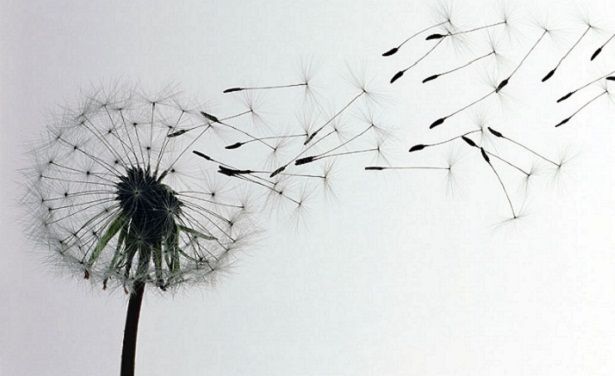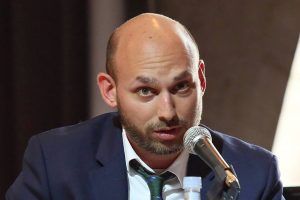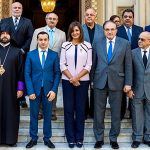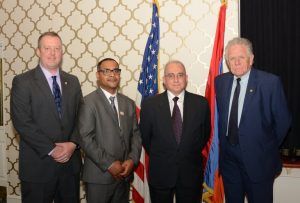Yuri Petrosyan: The type of Armenian
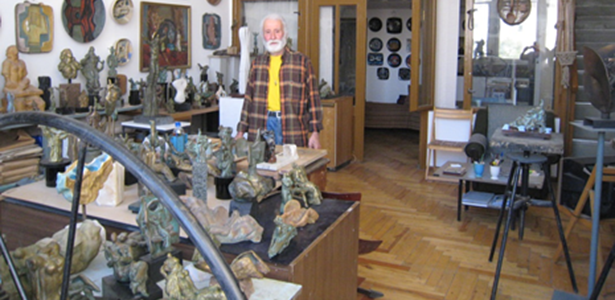
A stone “comes to life”, and the petrified “second” becomes immortalized for centuries at the moment of leap. The stone “sings” and “shows its grace”. It “talks” and “tells” my story and your story. Our dreams and thoughts are conveyed to the substance and reaffirm that the type of Armenian is the type that creates, sculpts, is infinitely kind and much more modest than his talent and grandeur.
Hayern Aysor’s correspondent sat down for an interview with Merited Painter of the Republic of Armenia, sculptor Yuri Petrosyan.
Hayern Aysor: How and when did you start painting and sculpting? When did you study the arts and take your first steps in the world of arts?
Yuri Petrosyan: I have been in love with painting since childhood. I have been painting since I was in the third or fourth grade. In the beginning, I would reproduce paintings. There is a sad and interesting story behind the first sculpture that I created. I had sculpted a small bas relief from wall plaster and had hung it in a corner of the bathroom. When I woke up in the morning, I saw that the sculpture was no longer there. It had fallen into a bucket of water and melted. This awakened the desire to continue and sculpt again and again.
I attended sculpting lessons at the Pioneer Palace in Yerevan for a year. After learning the ABCs of sculpting, I got accepted to Terlemezyan Art School. My classmates and I were deeply in love with and devoted to sculpting. We would work almost all day. After classes, we would make sketches in gardens and go home when it got dark, waiting impatiently for our classes the next day. My teacher was sculptor Suren Nazaryan (creator of the statue of Gai).
After finishing my studies, I got accepted to the Department of Sculpting at Yerevan State Institute of Arts and Theater. Our teacher was sculptor and founder of the Institute Ara Sargsyan.
It was Suren Nazaryan and Ara Sargsyan who instilled in me the love for the arts and sculpting.
Hayern Aysor: What does sculpting mean to you? Who inspires Yuri Petrosyan the sculptor?
Yuri Petrosyan: For me, sculpting is a lifestyle. It is my life. I can’t imagine myself in any other field. I also paint and perform graphic works.
Nature is like a big school. It gives me a great opportunity to look, see, feel and reproduce. You can learn something from every leaf and branch. Our stones, cliffs and mountains are already wonderful “sculptures” shaped by nature. You can take and learn a lot from them.
Hayern Aysor: You have been participating in exhibitions in Armenia and abroad since 1965. Where have your works been showcased? When and where have you held your personal exhibitions?
Yuri Petrosyan: In 1965, I received a silver medal at the republican youth exhibition in Armenia. My works have been showcased in Moscow, as well as in Canada in 1969. In 1976, I participated in an international sculpting symposium held in Ruzhbakh, Slovakia. In two months, I created the sculpture called “Tree of Life”, which was placed at the permanent open-air exhibition in Ruzhbakh. In 1992, my works were showcased at the Grand Pale Gallery in Paris. In 2004, my 2.5 meter high bronze sculpture was placed in the German city of Brehmen.
I have also held personal exhibitions in Yerevan (1992 and 2012) and Riga (1989).
My works are showcased at the National Gallery of Armenia and its branches, the Tretyakov Gallery in Moscow and the State Museum of Oriental Art.
Hayern Aysor: Your sculptures are also placed in the heart of Yerevan and have become a part of the image of the city. You have sculpted the statues of Khachaturian and Aivazovsky. When did you place your first sculpture in Yerevan? Which of your other sculptures are placed in Yerevan or other places in Armenia?
Yuri Petrosyan: The first of my sculptures placed in Yerevan is the sculpture called “Tree of Life”, which is made from tuff and placed next to Rosia Movie Theater. In 1973 or 1974, it was displaced.
There are two bronze bas reliefs placed at the frontal of the building of Moscow Cinema. The first is devoted to Sayat-Nova, and the other is devoted to theater.
I have participated in the tender for sculpting the statue of Aram Khachaturian. The tender was held in stages, and I received the first prize in the fourth stage. Nevertheless, the sculpture wasn’t being placed for a long time, and the government didn’t have funding to finish the project. Only in 1999 was the statue placed near the entrance to Aram Khachaturian Grand Concert Hall under the sponsorship of benefactor Senik Gevorgyan.
I received the first prize in the tender for sculpting the statue of Hovhannes Aivazovsky and was granted the right to construct it. In 2003, the statue of Hovhannes Aivazovsky was placed under the sponsorship of the same benefactor near the Chamber Music Hall on Moskovian Street.
I am very proud and honored to have sculpted the statues of two great and genius Armenians.
In 2004, the “Awakening” monument was placed in front of the building of Prometey Bank at Byuzand Street. In 2010, the bust of 12th century Armenian scientist and doctor Mkhitar Heratsi was placed in Heratsi Square.
As for the large-scale reliefs, I can mention the tuff reliefs placed on the right and left sides of the portal of Vardan Atchemyan Theater in Gyumri.
Hayern Aysor: What does Yerevan mean to you? What are you satisfied with? What worries or is unacceptable for Yuri Petrosyan the man, the citizen and the artist? What is your opinion of the current architectural and urban development solutions and the new statues and groups of statues placed in central Yerevan?
Yuri Petrosyan: I would like to mention any names or distinguish anyone. Of course, there are successful sculptures and monuments that have been placed in the past and were recently placed, and they beautify our city and turn it into a city/museum. As far as the newly built buildings, there are highly professional structures, but they are not always placed in the right places and distort the overall architectural environment. Of course, this is painful.
Yerevan is my hometown, and I can’t imagine living in another place. If we compare today’s Yerevan with the old Yerevan, a lot has changed. Unfortunately, there is less warmth, and people are not very kind to each other.
Hayern Aysor: You have small, large-scale and monumental sculptures. Which sculptures do you think reveal and embody your creativity more?
Yuri Petrosyan: There are many small sculptures in my workshop. They are often referred to as miniature sculptures. In reality, they are ideas, each of which could have been big and could have beautified the squares and gardens of the city. My dream is to see those sculptures decorate any corner of our city someday in greater volumes.
Hayern Aysor: You illustrate decorative plates. When did you fall in love with this field of art?
Yuri Petrosyan: In 1967, I visited Latvia for the first time. The two-month all-Union meetings would gather painters and sculptors from various republics. I made my first attempts there. In the beginning, my plates were decorated with reliefs. Now, I express my ideas with more colors and with more articism.
Hayern Aysor: You are the lucky contemporary of great Armenian artists. What are your memories of your fellow artists? Whom would you set aside?
Yuri Petrosyan: I am proud to mention that I have many friends who are talented artists. Great artist and sculptor Ara Shiraz is my childhood friend. We paved our way together and have been friends all our lives. Unfortunately, he passed away three years ago. Other artists of my generation are sculptors Hrant Hovsepyan and Yervand Gojabashyan, as well as painters Robert Elibekyan, Eduard Kharazyan and Ruben Adalyan.
Hayern Aysor: What problems do Armenian and Armenia-based sculptors face today? Is sculpting really in demand in our days? Does the government sponsor exhibitions and competitions to reveal new artists?
Yuri Petrosyan: Sculpting is a precious art, and there are many substances involved. An artist is incapable of turning all of his ideas into stone or bronze. There is a need for a state approach and state sponsorship. All artists feel the need for that today. Benefactors or organizations organize competitions and award ceremonies from time to time, but that is not a solution. Sculptors today mainly take orders. I think the government needs to provide funding, just like the government did in the Soviet era.
Hayern Aysor: There is a new generation of young Armenian painters and sculptors. Do we Armenians really have presentable artists who can present Armenian arts and culture in the world?
Yuri Petrosyan: There are many talented painters and sculptors who present their works in Armenia or abroad and participate in international exhibitions. I definitely believe that we are transmitting the art to young and talented artists.
Hayern Aysor: Do you consider yourself a happy person? What does happiness mean to Yuri Petrosyan?
Yuri Petrosyan: I am happy that I have a nice family, wonderful children and grandchildren and good friends.
Interview by Aghavni Grigoryan




 Արևելահայերեն
Արևելահայերեն Արևմտահայերեն
Արևմտահայերեն Русский
Русский